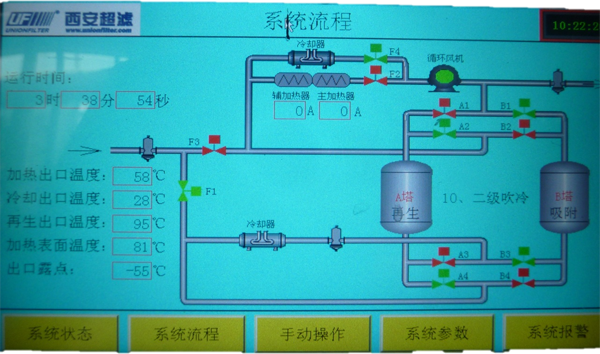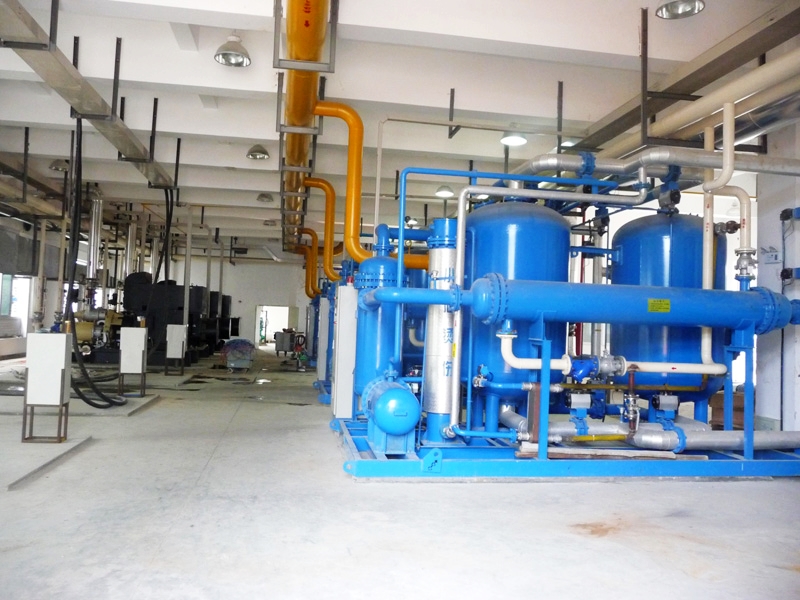新闻动态
Introduction to the Fourth Generation Super Adsorption-Type Drying and Filtration System
责任编辑:作者:admin人气:143 发表时间:2025-07-22
I. Problem Statement:
According to the statistics of the China Compressed Air Association, various compressors account for nearly 10% of the national electricity generation. The energy consumption of the first-generation adsorption dryers (without heat and with slight heat) accounts for 15% to 20% of the input power of the air compressor, making them a typical low-value high-energy-consuming product. The GB compressed air station design specification (2012 edition) has included them in the restricted use product category (based on a 20 m3/min threshold).
2. The traditional (second-generation) waste heat regeneration dryer has seen significant progress in centrifugal compressors over the past decade. Its exhaust temperature has decreased from the original 120-140°C to 90-110°C, or even lower. The heat value has dropped significantly, resulting in an increase in the dew point of the product gas, which can only reach the pressure dew point (7 bar) of -10°C to 0°C. Therefore, the GB 2012 edition specification has classified it as a refrigerated dryer application range or an intermediate product between refrigerated dryers and other adsorption dryers. Additionally, the traditional waste heat dryer still requires consuming a large amount of product gas (5% to 8%) to cool the heat tank (with an average temperature of about 100°C). To avoid the huge air consumption caused by this, the current tacit rules all adopt a small air volume (1-3%) for apparent cooling, followed by a forced switch. The cost is that within 0.5 to 1 hour, the adsorbent does not participate in adsorption in the hot state, and the dew point rises significantly (drifts) by 20-30°C. During this stage, the output moisture content of the dryer increases by several times or even hundreds of times.

II. Fourth-generation super-dry filtration system functions and key technologies:
This system has three main functions: low dew point, low drift, and zero gas consumption.

Low dew point: The atmospheric pressure dew point can reach below -60℃ (the regeneration intake temperature at 7 bar is ≥ 90℃)
Low drift: Using large volume and low-temperature gas blowing for cooling, the dew point drift is ≤ 5 - 10℃ (within 0.5 hours)
Zero gas consumption: During the regeneration process (heating/cooling), 5 - 8% of the product gas is fully recovered, with 100% zero gas consumption.
Five major systems:
1) Air compressor waste heat utilization system: 95% of the regeneration energy comes from the waste heat of the air compressor.
2) Regeneration gas recovery system: Zero gas consumption during isobaric regeneration. 3) Auxiliary heating system (electric consumption is only 1-1.5% of the input power of the air compressor): Effectively reduces the outlet dew point.
4) Adsorption drying and filtration system: High efficiency, low resistance, long lifespan.
5) Intelligent control management system: Process control, load regulation, fault monitoring, dew point display.
Cost performance:
The equipment purchase price is three times that of the first-generation machine without heat regeneration, twice that of the micro-heating system, 1.5 times that of the second-generation machine (blowing air external heating, residual heat regeneration), and energy savings of 50% to 90%. The purchase price difference can be recovered within 3 to 6 months of normal operation.
Operating cost examples:
Taking 100 cubic meters (first-generation machine without heat, micro-heating) as an example, the annual operating costs are calculated by two methods:
1) Converted electricity cost is 500,000 to 600,000 yuan per year.
2) If the gas price is 0.15 yuan/m3, the operating cost reaches 1 million yuan per year.
If the gas price is 0.20 yuan/m3, the operating cost reaches 1.5 million yuan per year.
The operating cost of this system is less than 10% of that of the first-generation machine, which shows the huge energy-saving benefits.
上一篇:CNG汽车加气站脱水装置 应用体会与分析
下一篇:暂无



